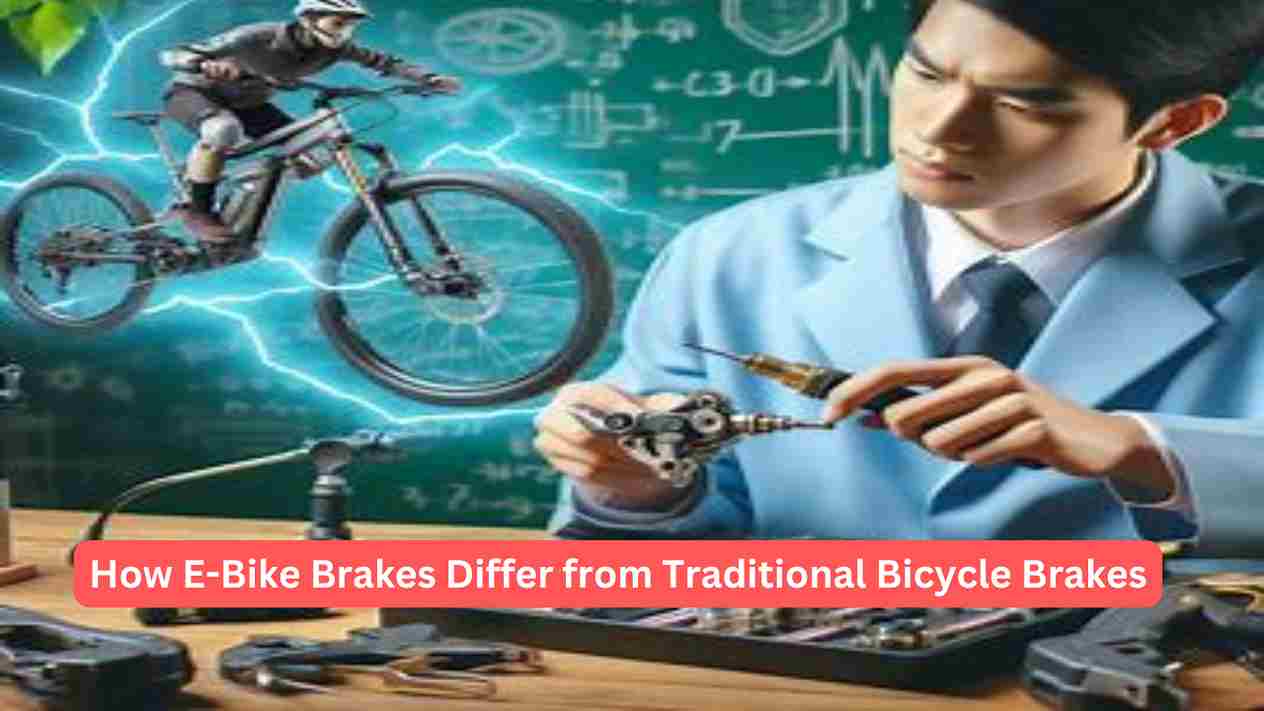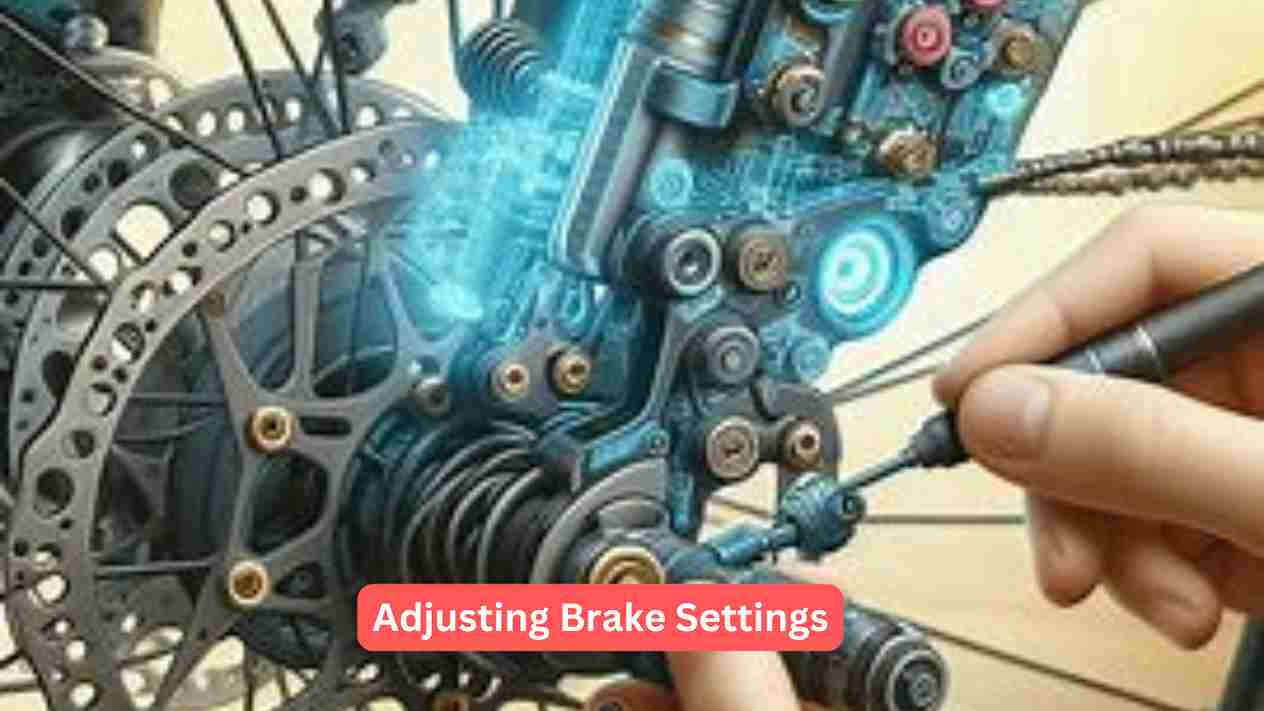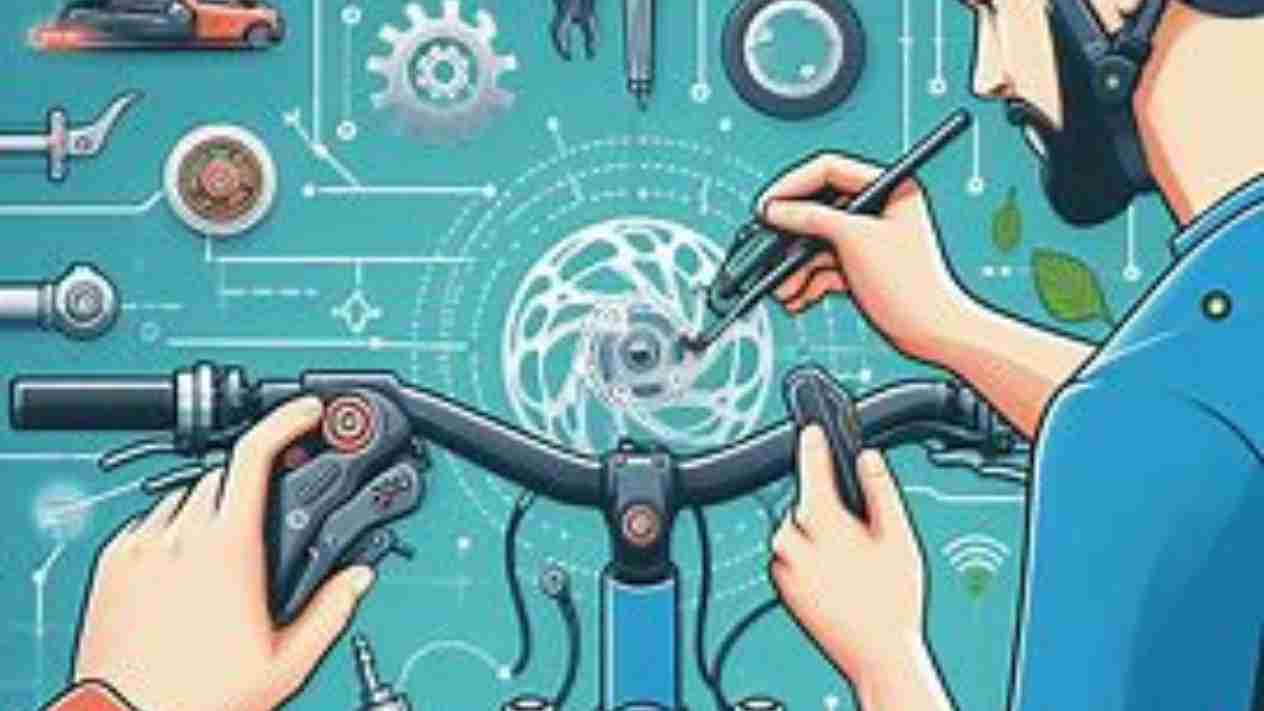How to Maintain E-Bike Brake Performance and Safety?
Maintaining the brake performance of your e-bike is crucial for a safe and enjoyable riding experience. E-bike brakes are fundamental for your safety, ensuring you can stop quickly and effectively when needed. Unlike traditional bicycles, e-bikes often come with more powerful motors and higher speeds, making reliable brake performance even more important.
Regular maintenance not only extends the life of your brakes but also prevents potential accidents caused by brake failure. In this guide, we’ll walk you through essential tips and practices to keep your e-bike’s brakes in top condition, ensuring both performance and safety on every ride.
1. Understanding E-Bike Brakes
To properly maintain your e-bike’s braking system, it helps to understand the different types of brakes commonly used and how they work. E-bike brakes are designed to handle the added weight and speed of electric bikes, which means they might differ from those on traditional bicycles. Here’s a breakdown of the key components:
Types of E-Bike Brakes
- Disc Brakes: These are the most common type of brakes on e-bikes and are available in two main varieties:
- Mechanical Disc Brakes: These use a cable to actuate the brake caliper, pressing the brake pads against a rotating disc (or rotor). They are known for their simplicity and ease of adjustment but may require more frequent maintenance.
- Hydraulic Disc Brakes: These use brake fluid to push the brake pads against the rotor. They offer superior stopping power and a smoother braking feel, though they can be more complex and costly to repair if something goes wrong.
- Rim Brakes: These brakes work by applying force directly to the wheel’s rim. While less common on modern e-bikes due to their reduced effectiveness in wet conditions and on heavier bikes, they can still be found on some models. Rim brakes are generally lighter and simpler but might require more frequent adjustments and have less stopping power compared to disc brakes.
How E-Bike Brakes Differ from Traditional Bicycle Brakes

- Increased Stopping Power: E-bikes can reach higher speeds and have greater weight due to the motor and battery, so the brakes need to be more robust. This often means that e-bikes use larger or more advanced brake systems compared to traditional bikes.
- Additional Considerations: The extra weight and speed of an e-bike can affect how the brakes perform and wear out. E-bike brakes might need to be adjusted more frequently or have different maintenance requirements compared to standard bike brakes.
Understanding the specific type of brakes on your e-bike will help you perform the right maintenance tasks and ensure your brakes are always functioning at their best.
2. Regular Inspection and Maintenance
Regular inspection and maintenance of your e-bike’s brakes are crucial for ensuring they perform reliably and keep you safe on the road. Here’s a guide to help you maintain your brakes effectively:
Routine Brake Check-Up
- Frequency of Inspection:
- Before Every Ride: Quickly check the brakes before each ride to ensure they’re functioning properly. Look for any visible signs of wear or damage.
- Weekly or Monthly: Depending on how often you ride, conduct a more thorough inspection on a weekly or monthly basis.
- What to Look For:
- Brake Pad Wear: Check the thickness of the brake pads. Most pads have wear indicators, but if they’re worn down to less than 1-2 mm, it’s time to replace them.
- Disc Alignment: Ensure that the brake disc (rotor) is properly aligned with the brake pads. Misalignment can cause uneven wear and reduce braking efficiency.
- Brake Fluid Levels (for Hydraulic Brakes): If your e-bike has hydraulic disc brakes, check the brake fluid levels regularly and top up if necessary. Low fluid levels can lead to reduced braking performance.
- Brake Cable Condition: For mechanical disc brakes, inspect the brake cables for fraying or damage. Replace any damaged cables immediately.
Signs of Wear and Tear
- Squeaking or Grinding Noises: If you hear unusual noises when braking, it may indicate worn brake pads or dirty rotors. Clean or replace the affected parts as needed.
- Reduced Stopping Power: If you notice that your brakes aren’t as responsive as usual, it could be due to worn brake pads, air in the hydraulic system, or other issues.
- Spongy Brake Feel: A spongy or soft brake lever may suggest air in the hydraulic lines or a need for adjustment in mechanical systems. Bleed the brakes or adjust as necessary.
Regularly inspecting and maintaining your e-bike’s brakes not only ensures safety but also helps prevent costly repairs down the line. By staying proactive with these checks, you can enjoy a smoother and more reliable riding experience.
3. Cleaning and Lubrication
Keeping your e-bike’s brakes clean and properly lubricated is essential for maintaining optimal performance and longevity. Dirt, grime, and lack of lubrication can negatively impact braking efficiency and safety. Here’s how to properly clean and lubricate your e-bike’s brakes:
Cleaning the Brake Components
- Cleaning Disc Brakes:
- Brake Rotors: Use a clean, lint-free cloth and isopropyl alcohol to wipe down the rotors. Avoid touching the surface with your fingers as oils from your skin can affect braking performance.
- Brake Pads: Remove the brake pads if needed and clean them gently with a brush or cloth. Be cautious with cleaning agents; use ones specifically designed for brake pads if necessary. If the pads are heavily contaminated or worn, consider replacing them.
- Calipers: Wipe down the brake calipers with a clean cloth to remove any dust or debris. Avoid using strong solvents that could damage the brake components.
- Cleaning Rim Brakes:
- Rims: Clean the rims with soapy water and a cloth to remove dirt and brake dust. Dry them thoroughly to prevent rust.
- Brake Pads: For rim brakes, clean the brake pads with a soft brush or cloth. If they are dirty or glazed, use a fine sandpaper to lightly roughen the surface. This helps improve braking performance.
Lubrication Tips
- Lubricating Moving Parts:
- Brake Caliper Pins: Apply a small amount of lubricant to the caliper pins to ensure smooth movement. Use a lubricant suitable for bike components.
- Brake Cables: For mechanical disc brakes, lightly lubricate the brake cables to prevent rust and ensure smooth operation. Apply a small amount of lubricant to the cable and work it into the housing.
- Recommended Lubricants:
- Use lubricants specifically designed for bike brakes and components. Avoid using general-purpose oils or solvents, as they might affect the performance of the brakes or cause damage.
- Dry Lubricants: Ideal for use in dry conditions as they won’t attract dirt.
- Wet Lubricants: Better for wet or muddy conditions as they resist washing off.
Proper cleaning and lubrication are crucial for maintaining the efficiency and safety of your e-bike’s braking system. By keeping your brakes clean and well-lubricated, you ensure smoother operation and extend the lifespan of your brake components.
4. Adjusting Brake Settings
Proper adjustment of your e-bike’s brake settings is key to ensuring effective braking performance and safety. Here’s a step-by-step guide to help you adjust your brake settings for optimal performance:

Brake Pad Alignment
- Checking Alignment:
- Disc Brakes: Inspect the alignment of the brake pads relative to the rotor. The pads should be centered on the rotor and parallel to it. Misalignment can cause uneven wear and reduce braking efficiency.
- Rim Brakes: Ensure that the brake pads are aligned with the rim and make full contact without rubbing on the tire.
- Adjusting Brake Pads:
- Disc Brakes: For mechanical disc brakes, adjust the caliper position using the mounting bolts to ensure that the pads are evenly spaced around the rotor. For hydraulic disc brakes, adjustments might require specialized tools or a professional mechanic.
- Rim Brakes: Adjust the position of the brake pads by loosening the pad mounting bolts and repositioning the pads so they make even contact with the rim. Ensure the pads do not rub against the tire or get in the way of the wheel.
Brake Cable Tension
- Adjusting Mechanical Brakes:
- Cable Tension: Use the barrel adjuster on the brake lever or caliper to fine-tune the tension of the brake cable. Turn the adjuster clockwise to increase tension and counterclockwise to decrease it.
- Check for Proper Tension: Pull the brake lever to test the tension. The brake pads should engage the rotor or rim firmly and without excessive lever travel.
- Hydraulic Brake Adjustment:
- Bleeding the Brakes: If the brake lever feels spongy, there might be air in the hydraulic lines. Bleed the brakes to remove air and restore proper brake feel. This process might require a hydraulic brake bleeding kit and specific instructions for your brake model.
Ensuring Proper Brake Lever Feel
- Brake Lever Position: Adjust the position of the brake lever to a comfortable reach for your hands. Most e-bike brake levers have an adjustment screw to fine-tune the lever’s reach.
- Brake Bite Point: For hydraulic brakes, you can adjust the bite point (the point at which the brakes engage) by adjusting the caliper or lever. Consult the manufacturer’s guidelines for specific instructions.
Regularly checking and adjusting your e-bike’s brake settings helps ensure that your brakes perform reliably and safely. Proper adjustment not only enhances braking efficiency but also contributes to a smoother and more enjoyable riding experience.
5. Replacing Brake Parts
Replacing worn or damaged brake parts is essential for maintaining your e-bike’s braking performance and safety. Knowing when and how to replace these parts can prevent accidents and ensure your brakes function correctly. Here’s a guide to help you with the replacement process:
When to Replace Brake Pads
- Signs of Worn Brake Pads:
- Thickness: Check the thickness of the brake pads. Most pads have wear indicators, but if they are worn down to less than 1-2 mm, it’s time to replace them.
- Noise: If you hear squealing, grinding, or other unusual noises when braking, the pads might be worn out or contaminated.
- Reduced Stopping Power: If you notice that your brakes are less effective or require more force to engage, the pads might need replacement.
- How to Replace Brake Pads:
- Disc Brakes:
- Remove the Old Pads: For mechanical disc brakes, loosen the caliper bolts and remove the old brake pads. For hydraulic disc brakes, you may need to use a special tool or follow the manufacturer’s instructions to remove the pads.
- Install New Pads: Slide the new pads into the caliper and ensure they are properly aligned with the rotor. Reassemble and adjust the caliper if needed.
- Rim Brakes:
- Remove the Old Pads: Loosen the mounting bolts on the brake caliper and remove the worn pads.
- Install New Pads: Position the new pads so they align correctly with the rim. Tighten the mounting bolts and check for proper alignment.
- Disc Brakes:

Replacing Rotors and Other Components
- When to Replace Brake Rotors:
- Warping or Damage: If the rotor is warped, cracked, or severely worn, it should be replaced. Warped rotors can cause pulsation or uneven braking.
- Thickness: Measure the rotor thickness with a caliper. If it’s below the minimum thickness specified by the manufacturer, replace it.
- How to Replace Rotors:
- Remove the Old Rotor: Loosen the rotor bolts and remove the old rotor from the hub.
- Install the New Rotor: Place the new rotor on the hub, ensuring it is properly aligned. Tighten the rotor bolts to the manufacturer’s specifications.
- Other Components:
- Brake Cables: If a brake cable is frayed or damaged, replace it to ensure smooth braking. Remove the old cable and install a new one, adjusting the tension as needed.
- Hydraulic Brake Lines: For hydraulic systems, if the brake lines are damaged or leaking, they should be replaced. This often requires professional servicing to ensure proper installation and bleeding.
Regularly inspecting and replacing brake parts helps maintain the safety and performance of your e-bike. By addressing worn or damaged components promptly, you ensure reliable braking and a safer riding experience.
6. Ensuring Safety During Rides
Ensuring safety during your rides involves more than just maintaining your e-bike’s brakes; it also includes being vigilant about brake performance and handling. Here are some key practices to help you stay safe while riding:
Pre-Ride Safety Checks
- Quick Brake Check:
- Test the Brakes: Before every ride, squeeze the brake levers to ensure they feel firm and responsive. Check that the brake pads engage the rotors or rims evenly.
- Inspect Brake Components: Look for any visible signs of wear or damage, such as worn pads or leaking hydraulic fluid. Ensure that all bolts and components are securely fastened.
- Check Brake Fluid Levels:
- Hydraulic Brakes: If your e-bike has hydraulic disc brakes, check the brake fluid levels before each ride. Low fluid levels can lead to reduced braking power.
- Examine Tires and Wheels:
- Tire Condition: Make sure your tires are in good condition, with sufficient tread and no visible damage. Properly inflated tires ensure better control and braking performance.
- Wheel Integrity: Check that the wheels are properly aligned and spin freely. Misaligned or damaged wheels can affect braking and handling.
What to Do if You Notice Issues During Your Ride
- Unusual Brake Feel:
- Spongy or Soft Brakes: If the brake lever feels spongy or soft, stop and inspect the brakes. You might need to bleed the hydraulic brakes or adjust the brake cable.
- Squeaking or Grinding: If you hear squeaking or grinding noises, it could indicate that the brake pads are contaminated or worn. Avoid heavy braking until you can address the issue.
- Handling Brake Issues:
- Temporary Solutions: If you experience a minor issue, such as a slight misalignment or noise, make temporary adjustments or use less aggressive braking until you can make proper repairs.
- Seek Help: For major issues or if you’re unsure about handling brake problems, it’s best to seek assistance from a professional mechanic.
Emergency Brake Handling
- Effective Braking Techniques:
- Use Both Brakes: Apply both the front and rear brakes evenly for maximum stopping power and stability. Avoid sudden or hard braking to prevent skidding.
- Controlled Stops: Gradually increase braking pressure to avoid locking the wheels and losing control, especially in slippery or uneven conditions.
- Emergency Situations:
- Stay Calm: In an emergency, stay calm and use your brakes smoothly to bring the e-bike to a stop. Avoid swerving or abrupt movements that could cause loss of control.
- Plan Ahead: Maintain a safe distance from other vehicles and obstacles. Anticipate potential hazards and be prepared to react calmly.
By conducting regular pre-ride checks and being aware of how to handle brake issues and emergencies, you can ensure a safer riding experience and respond effectively to any braking problems that arise.
Also Read: How E-Bike Pedal-Assist Systems Work Cadence And Torque Sensors?
Conclusion
Maintaining the brake performance of your e-bike is essential for both safety and enjoyment on the road. By understanding the different types of e-bike brakes, performing regular inspections, cleaning and lubricating components, adjusting settings, and replacing worn parts, you ensure your braking system remains reliable and effective. Regular upkeep not only extends the life of your brakes but also enhances your overall riding experience by providing consistent and responsive stopping power.
Remember, a well-maintained brake system is a crucial part of safe e-bike riding. By following these guidelines and staying proactive with maintenance, you can confidently navigate your rides, knowing your brakes are up to the task. Keep your e-bike’s braking system in top shape, and enjoy a smoother, safer, and more enjoyable journey every time you hit the road.